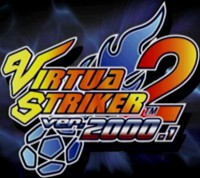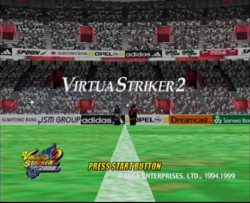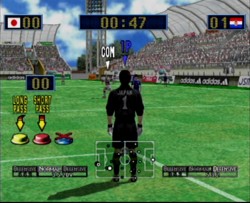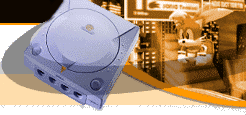| |
Virtua Striker 2
Great, arcade style foot.. err, soccer - Review By Tren
 The original Virtua Striker, by Sega arcade geniuses AM2, was released to much acclaim in 1994 on Sega's arcade board Model 2. The game boasted fast and fun football (or soccer to you Americans) action which anyone could pick up and play, without the need to learn many different buttons. The game was a huge success in the arcades, unsurprising considering there were and still are few arcade footie games around. The game has been updated progressively with new Sega hardware, first to Model 3, then to Model 3b, and most recently to the powerful Naomi board. Due to the similarity between the Naomi and Dreamcast hardware, Naomi to DC conversions can be darn near perfect. The original Virtua Striker, by Sega arcade geniuses AM2, was released to much acclaim in 1994 on Sega's arcade board Model 2. The game boasted fast and fun football (or soccer to you Americans) action which anyone could pick up and play, without the need to learn many different buttons. The game was a huge success in the arcades, unsurprising considering there were and still are few arcade footie games around. The game has been updated progressively with new Sega hardware, first to Model 3, then to Model 3b, and most recently to the powerful Naomi board. Due to the similarity between the Naomi and Dreamcast hardware, Naomi to DC conversions can be darn near perfect.
So, how does the home rendition of Sega's Naomi-based soccer title fare?
The Good

The intro flyby really shows off the great graphics. |
The first thing to hit you will be the graphics. This game really does look the business, running at a rock solid 60 frames per second, with fantastically detailed players and stadiums. Virtua Striker 2 is really a graphical treat. The crowd is the best yet in a soccer game, and although limited to just basic animation, they still look quite realistic, thanks to their waving flags and such. The player animation is fluid and doesn't suffer from the jerkiness associated with the FIFA games since their transition into 3D. Also, the pitch is very detailed, being more muddy around the centre and goal mouths. The game physics are near perfection with the ball bouncing perfectly, violently rebounding off the goal bar/posts, and sending a cascade of ripples down the goal nets as a 40-yard screamer rockets into the top corner. The colours are vibrant and the whole game seems alive, contributing to the carnival atmosphere typically associated with a World Cup match.
Apart from the obligatory arcade mode there are few new additions, although the ones there are are excellent, especially the ranking mode. The other modes include a league option and standard versus matches. Sega has also made a few additions to the configuration options. However, the only two of much use are the ability to toggle between real length halves, and to swap ends at half time. The other excellent addition is the ability to save your best goals to your VMU, although they can take up to 35 blocks at a time so one of the larger 3rd party VMUs will be a worthwhile investment if you want to create your own highlights show. The game has only one camera angle (from the side, TV style), but thankfully it zooms in and out, and displays all the pitch you need to see (except when you're on the far side of the field). Although you are limited to just one view in-game, the view can be changed around when playing back saved goals.

GOOOOOAAAAAL!!! |
Although all soccer games are based around the same set of rules, they all differ in their interpretation of how the player should control the game. This is where Virtua Striker 2 shows its arcade heritage, which can be good or bad depending on what you're looking for in a soccer game. The game has quite a simplified control system compared to other soccer titles, with only 4 buttons used. These are for shooting, long passing (or slide tackling when you don't have possession), short passing, and formation changing (out of a selection of three pre-set for each team). Although this reduces the scope for tactics somewhat, it does actually make the game more like a fighting game, in terms of mastery. Combinations of attacks and tactical positions yield goals, whilst others defend goals which makes for an intense and enjoyable 2 player experience (once a few initial gripes have been overcome.. more on those later). Scoring an amazing goal in the 2 player mode really gets the adrenaline pumping.
The sound in Virtua Striker 2 isn't particularly impressive, although one great addition (or rather lack of it) is there's no annoying commentary. The crowd noises are great with quite a variety of samples, although the tackling noise does get repetitive after a while, sounding more akin to someone sneezing than a sliding tackle across turf. The actual ball makes a great sound when landing or being kicked, and it looks very impressive to boot (pun not intended) being a fully polygonal and very spherical affair.
The Bad
As I said earlier, opinions on this game will differ, as its simpler control will be seen as a gripe by some people. The lack of a complex control system can be the game's downfall if you want a more involving and strategic game of soccer. The most glaring omission for people after a game like this will undoubtedly be the lack of a 'run faster' button. All players run at the same speed, meaning to create goals you have to pass the ball around your players until you either end up with a break towards the box, down the flanks for a cross, or you lose possession to the other player. The game also has no 'change player' button, which is ok for most of the time as the game will pick the correct player for you. But sometimes when attacking, the player nearest to the ball might be down or recovering from a slide tackle, in which case he is not the best player to have selected. Unfortunately, the game will put him under your control regardless.

You get a nice third person view when throwing the ball back into play. |
The other major annoyance is there's no support for the analogue pad, another sign of the game's arcade heritage. Although this is initially frustrating, especially if you have got used to the accuracy of the analogue pad in soccer games on other formats (such as ISS64 on the N64), with time it becomes less annoying. However, this combined with the slow turning players can be enough to put off newcomers to the game straight away.
The options that have been added to the game for the home version, apart from the real time counter and swapping ends each half, are detrimental to the gameplay. In particular, the "offside" option ruins the game's fast and furious arcade-style gameplay, and the "cards" option reduces slide tackles to pot luck.. Sometimes you get booked, and sometimes you don't. I recommend you leave both of these options off.
Finally, the lack of a 4 player option is disappointing. Considering how much the game shines in multiplayer mode, 4 players at once could have made the game even better. Hopefully, the upcoming Dreamcast ISS game from Konami will build upon Virtua Striker 2's successes, whilst keeping the superlative gameplay associated with Konami's soccer titles (and its 4 player mode).
The Final Word
Virtua Striker 2 isn't the easiest of games to review as opinions on it will differ. Personally, I like it, especially the ranking and multi player modes. However, it may not be what you're looking for in a soccer game - you may want a more in-depth simulation. Playing it for one night is not enough to get used to the game, and you really need to get used to its style before dismissing it outright. Given time, you may grow to enjoy its quirky, arcade-style interpretation of soccer.
Developer: Sega AM2
Publisher: Sega
Genre: Sports
Highs: Great graphics, fast and furious soccer, 2 player mode, VMU goal saving.
Lows: Lack of depth, few useful new additions, no analogue pad support.
Other: 1-2 players, VMU Compatible (one save requires 12 blocks), VGA Compatible.
|
Final Score:

(out of a possible 10)
|
Previous Reviews
Comments on this review? Mail Feedback.
|

